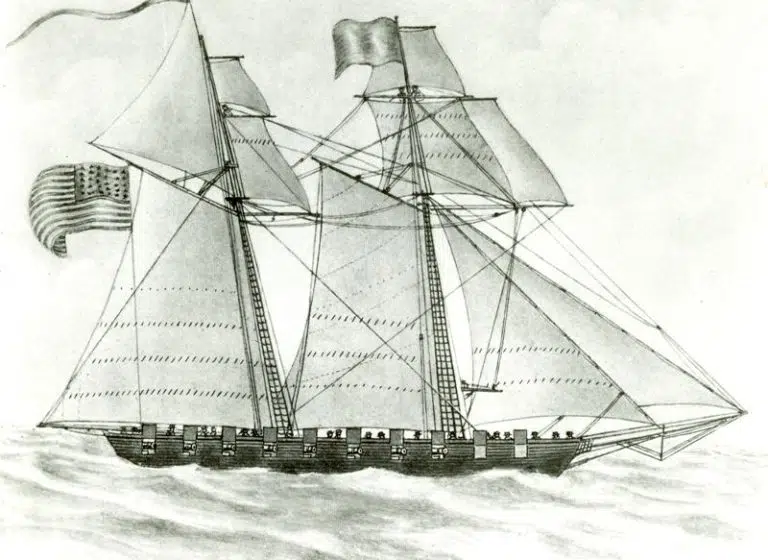On August 4, 2020, the Coast Guard turned 230 years old. Founded just fourteen years after the Revolutionary War, it’s the oldest, continuous seagoing service in the U.S, predating the U.S. Navy by eight years. The brainchild of Alexander Hamilton, this branch of the military was originally called the Revenue Marine. Its primary responsibility was to ensure the collection of customs duties at U.S. seaports, which at the time were losing substantial sums of money due to smugglers who avoided tariffs.
The Revenue Marine’s inaugural fleet consisted of ten sleek and speedy cutters. These topsail schooners were sometimes equipped with a swivel cannon, an indication of just how dangerous the job of a revenue mariner could be. The cutter ship soon became emblematic of the Revenue Marine, so much so that the agency quickly gained the nickname “Revenue Cutter Service”—a designation that Congress made official in 1894. The “cutter” tradition stuck, and even today, the long, high-powered boats operated by the Coast Guard are referred to as cutters.
By the time the Revenue Marine officially became the Revenue Cutter Service, the agency’s duties had expanded considerably. These new duties included rescuing mariners in distress, charting the coastline, defending the seacoast from military attack, and even capturing pirate ships. In 1915, the agency changed its name again, when the Revenue Cutter Service merged with the U.S Life-Saving Service to become the Coast Guard that we know today.
Small but Mighty
With only 41,000 active-duty members, the Coast Guard is the smallest branch of the armed services. But it has significant responsibilities: ensuring the safety of life at sea and enforcing U.S. maritime law. The agency is responsible for protecting 95,000 miles of U.S. coastline and waterways, and even operates in international waters. The modern Coast Guard is a multi-mission service with five key roles: ensuring maritime safety, security, and mobility; providing national defense; and protecting natural resources.
As the frequent name changes indicate, the Coast Guard legacy is one of adaptation. While the agency’s mission remains fundamentally unchanged, the methods and tools it uses have evolved considerably in 230 years.
The agency’s cutters, for example, are specialized now. There are a dozen or so different types used by the Coast Guard, ranging from reliable harbor tugs to speedy patrol ships to behemoth icebreakers. Some cutters are so big that they include landing pads for helicopters, which are now a standard part of Coast Guard equipment, along with half a dozen types of planes.
In addition to large cutters, the Coast Guard fleet includes hundreds of smaller boats used for emergency response and related duties. (Fun fact: Cutters are Coast Guard seacraft that are at least 65 feet long. Anything smaller is a boat.)
A Legacy of Maritime Protection
The Coast Guard’s current duties extend far beyond anything the Founding Fathers could have imagined. For example, the organization now has its own special forces team. Known as the Maritime Safety and Security Team (MSST), it was created in 2002 in response to the terrorist attacks of 9/11. The MSST guards America’s seaports and protects critical shipping lanes and vessels. It is the only special forces team authorized to arrest submerged scuba divers.
Another of the Coast Guard’s lesser-known responsibilities is its leadership in the International Ice Patrol. The Ice Patrol was founded in 1913, just months after the HMS Titanic sank after hitting an iceberg, killing over 1,500 passengers and crew. Today, the International Ice Patrol monitors the North Atlantic Ocean and alerts the maritime community to any dangerous icebergs. Although the International Ice Patrol is supported by a consortium of thirteen nations, responsibility for Patrol operations rests solely with the Coast Guard.
Even the Coast Guard’s traditional duties have expanded. Its rescue operations, for example, are more frequent and far-ranging than ever before. On average, the Coast Guard conducts 45 search-and-rescue missions and saves ten people every day. During that same 24-hour period, it will save over $1 million worth of property, and complete nearly 30 safety examinations of foreign vessels.
The organization’s policing duties have also grown over the past two centuries, especially as regards contraband. Though the Coast Guard has been intercepting smugglers since its inception, it must constantly adapt its methods to counteract today’s drug smugglers, who are far more sophisticated and better equipped than their predecessors.
PRIDE Welcomes Coast Guard Veterans
As with other military personnel, the training that Coast Guard members receive while in service makes them valuable employees once they return to civilian life. PRIDE Industries is fortunate to employ several Coast Guard veterans, along with dozens of veterans from other branches of the military.
To seek out these highly valued employees, PRIDE developed the Military Skills Translator, an online tool designed specifically for veterans. With the Skills Translator, veterans can easily determine which civilian jobs best correspond to the valuable experience they gained while serving our country.
At PRIDE, we see every day how veterans of the Coast Guard contribute to their communities even after they’ve left active service—a tradition that stretches all the way back to the Revenue Marine.

